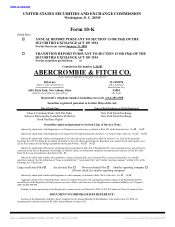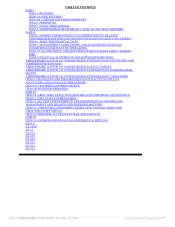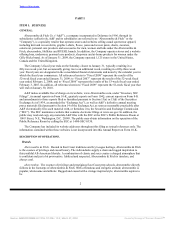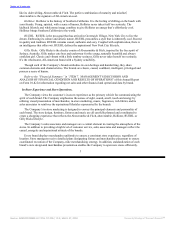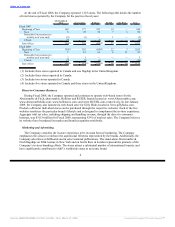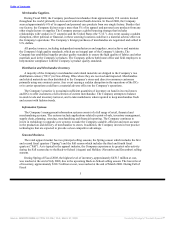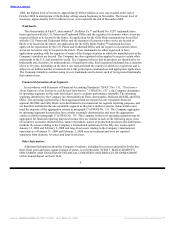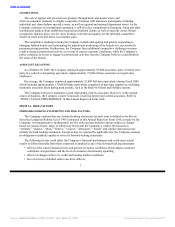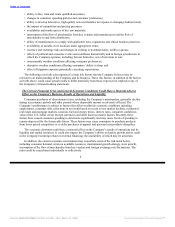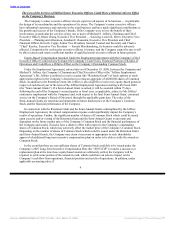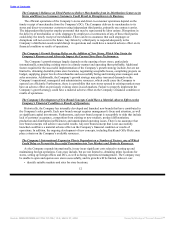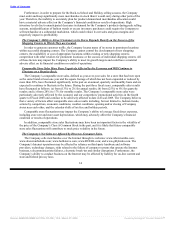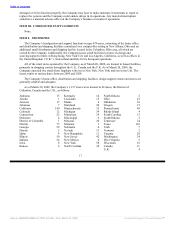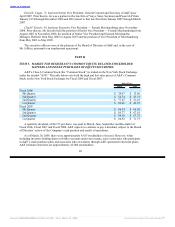Abercrombie & Fitch 2008 Annual Report Download - page 12
Download and view the complete annual report
Please find page 12 of the 2008 Abercrombie & Fitch annual report below. You can navigate through the pages in the report by either clicking on the pages listed below, or by using the keyword search tool below to find specific information within the annual report.
Table of Contents
the Company’s stock price increases to a point where, as of any measurement date, the Company would
be unable to settle outstanding equity-based awards in shares of Common Stock from such plans, in
accordance with Statement of Financial Accounting Standards No. 123(R), “Share-Based Payment”, the
Company will be required to classify and account for all or a portion of the equity-based awards as
liabilities. This could further adversely impact the Company’s results of operations.
The Failure to Anticipate, Identify and Respond to Changing Consumer Preferences and Fashion
Trends in a Timely Manner Could Cause the Company’s Profitability to Decline.
The Company’s success largely depends on its ability to anticipate and gauge the fashion preferences
of its customers and provide merchandise that satisfies constantly shifting demands in a timely manner.
The merchandise must appeal to each brand’s corresponding target market of consumers whose
preferences cannot be predicted with certainty and are subject to rapid change. Because the Company
enters into agreements for the manufacture and purchase of merchandise well in advance of the applicable
selling season, it is vulnerable to changes in consumer preference and demand, pricing shifts and the
sub-optimal selection and timing of merchandise purchases. There can be no assurance that the Company
will be able to continue to successfully anticipate consumer demands in the future. To the extent that the
Company fails to anticipate, identify and respond effectively to changing consumer preferences and
fashion trends, its sales will be adversely affected. Inventory levels for certain merchandise styles no
longer considered to be “on trend” may increase, leading to higher markdowns to reduce excess inventory
or increases in inventory valuation reserves. The current economic and retail environment, in which many
of the Company’s competitors are engaging in aggressive promotional activities, exacerbates the
importance of changing consumer preferences and fashion trends. Each of these could have a material
adverse effect on the Company’s financial condition or results of operations.
The Company’s Market Share may be Adversely Impacted at any Time by a Significant Number of
Competitors.
The sale of apparel and personal care products through brick-and-mortar stores and
direct-to-consumer channels is a highly competitive business with numerous participants, including
individual and chain fashion specialty stores, as well as regional and national department stores. The
Company faces a variety of competitive challenges, including:
• maintaining favorable brand recognition and effectively marketing its products to consumers in
several diverse demographic markets;
• sourcing merchandise efficiently; and
• countering the aggressive promotional activities of many of the Company’s competitors without
diminishing the aspirational nature of the Company’s brands and brand equity.
There can be no assurance that the Company will be able to compete successfully in the future.
The Interruption of the Flow of Merchandise from Key Vendors and International Manufacturers
Could Disrupt the Company’s Supply Chain.
The Company purchases the majority of its merchandise outside of the U.S. through arrangements
with approximately 210 vendors which include 314 foreign manufacturers located throughout the world,
primarily in Asia and Central and South America. In addition, many of the Company’s domestic
manufacturers maintain production facilities overseas. Political, social or economic instability in Asia,
Central or South America, or in other regions in which the Company’s manufacturers are located, could
cause disruptions in
10
Source: ABERCROMBIE & FITCH CO /DE/, 10-K, March 27, 2009 Powered by Morningstar® Document Research℠


